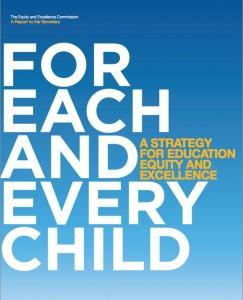Book: For Each and Every Child: A Strategy for Education Equity and Excellence by The Equity and Excellence Commission
Genre: Government Document
Publisher: U.S. Department of Education
Publication date: 2013
Pages: 52
Source: Electronic public domain pdf file: For Each and Every Child
 A government document that’s both readable and important
A government document that’s both readable and importantSummary: Education is an economic issue. “America has lost its place as a global leader in educational attainment in ways that will lead to a decline in living standards for millions of our children and the loss of trillions of dollars of economic growth.” (p. 12) Regaining our place as a global leader in education and economy will require equity. We can’t get there by giving a top-tier education to our most advantaged students — there simply aren’t enough of them to sustain a world-class economy. We only get there by giving a top-tier education to all of our students.
We have a long way to go. Children in the highest-poverty schools in the US read on par with the world’s lowest-achieving countries.
Equity is a key strategy needed to shore up the entire nation’s standing in the global economy; we cannot compete successfully with one arm tied behind our back. Any goal of competitiveness and excellence must start with equity or be doomed to fail. (p. 12)
The US, with its strong and unusual tradition of welcoming and incorporating diverse groups into the tapestry of the nation, should have a unique advantage. But we don’t because we continue to segregate by wealth, income, and race while providing disadvantaged students fewer resources.
As a result, we take the extraordinary diversity–including linguistic backgrounds and familial relationships–that should be our strategic advantage in the international economy and squander it. (p. 14)
Compared to other developed nations, we’re blowing it.
America has become an outlier nation in the way we fund, govern and administer K-12 schools, and also in terms of performance. No other developed nation has inequities nearly as deep or systemic; no other developed nation has, despite some efforts to the contrary, so thoroughly stacked the odds against so many of its children. Sadly, what feels so very un-American turns out to be distinctly American. (p. 15)
Thoughts: I had a hard time deciding whether to review this first or Fragmented by Design by E. Terrence Jones, our most recent book club selection. The two have become intertwined in my mind and it’s hard to write about one without referencing the other. But, I completed For Each and Every Child first, so I’ll review it first. Watch for more discussion in my review of Fragmented by Design, later this week.
I’ve been sitting on these for weeks due to the above confusion, but I got motivated to act because the Ferguson Commission posted it’s draft of 200 Calls to Action (Google doc) last week, ahead of the final report that’s due in September.
The For Each and Every Child report was recommended to me by Ferguson Commissioner, Becky James-Hatter, co-chair of the Child Well-Being and Education Equity Working Group. I mentioned an interest in reforming the tax structure that supports education and she suggested this document, for which I’m grateful.
The situation in the St. Louis region is exactly as described in For Each and Every Child:
The common situation in America is that schools in poor communities spend less per pupil–and often many thousands of dollars less per pupil–than schools in nearby affluent communities, meaning poor schools can’t compete for the best teaching and principal talent in a local labor market and can’t implement the high-end technology and rigorous academic and enrichment programs needed to enhance student performance. (p. 14)
Kirkwood High School, near my house, is only 16 miles from Normandy High School, the unaccredited school where Michael Brown graduated. The differences are stark and have long-reaching impact on our whole region.
I had hoped that the Calls to Action from the Working Group for Child Well Being and Education Equity might include a grand vision to fix disparity in educational funding by either moving away from property tax as a funding source or by consolidating school districts so that Kirkwood and Normandy shared the same administration, pool of money, and goals. In my quick look through the 49 (!) Calls to Action from that one Working Group, I didn’t see either of those.
After reading Fragmented by Design, though, I’m not surprised. Neither of those ideas were likely to be feasible no matter how much sense they make to me and everyone I talk to about this topic. From what I learned in Fragmented by Design, the ideas that are presented near the bottom of the list for Coordination and Innovation are more likely to succeed in our region.
Appeal: This is a terrific report! I had so many more quotes and thoughts I wanted to share because there was so much more that inspired me. For Each and Every Child is very readable and I recommend it to any one who has an interest in children, education, or the future of the United States.
Besides reading this report, how do you think we can all be more involved in improving education in the US as students, parents, school personnel, and ordinary citizens?

